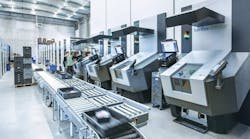So a guy walks into a suite and pulls the sparger out of what he thinks is an empty bioreactor and ends up dumping a $3 million-batch of biologics on the floor—oops. No, this isn’t the start of a bad pharma joke, this is a real story I heard from a customer in the industry, which completely changed the way I thought about how humans operate in complex, compliance-driven environments. With the right technology, that man could have avoided making that mistake, or others, at work.
It is my firm belief that the combination of humans and technology yields greater productivity, control and reliability in a workspace than if each entity operates independently. This is especially true for the pharma and biotech industries in which you have scientists and engineers handling biohazardous materials, working on time-sensitive projects and operating highly specialized equipment and has been proven over the last 3 ½ years with our customers around the world. The efforts put forth by that workforce have a direct impact on the rest of us in the world who rely on safe drug production, clinical trial research, or the manufacturing of everyday consumer goods.
[pullquote] In 2014, I co-founded my company, Apprentice.io, with the vision of creating a synergistic relationship between humans and technology in the workplace. I wanted to provide industrial that solved everyday problems and made a workforce stronger.
That mission wasn’t easy at first. We had to first educate people about the potential and benefits that AR technology can provide. Back then people were hesitant to trust and integrate advanced software like AR in a real way. There was this fear that too much tech may lead toward a dystopian Brave New World society in which tech and machines take over. I couldn’t disagree more.
AR is one of the most promising digital technologies transforming all major enterprise industries.
It’s changing the way companies do business and compete for space within their respective arenas. In my opinion, the life sciences—especially pharma and biotech —stand to gain the most from AR, machine learning and computer vision. There is far more to be gained than just entertainment and fun.
It’s been my personal experience that pharma and biotech companies are more educated about this type of technology and are therefore significantly more willing to adopt it into the workplace, which is why these industries served as my inspiration when I first co-founded Apprentice. Major Fortune 100 pharma and biotech companies were approaching us with use cases and problems they needed solved that only AR technology could provide.
The truth is that when applied smartly, this technology unleashes the fullest potential of scientists and engineers operating in these environments. Imagine easily visualizing procedures, generating immediate solutions and checking for errors before making them.
I realized early on in development that with AR in pharma we could remove the physical restrictions experienced in lab and manufacturing suites caused by manual data recordation, referencing SOPs, or waiting for on-site vendor assistance, all while improving audit readiness and providing risk-free training. We’re talking about safer, more reliable lifesaving research, reducing overhead cost, improving workplace conditions and streaming workplace operations. The applications for using AR for a greater social good are limitless.
Luckily, there’s been a shift in adoption and understanding as enterprises begin to recognize the value and real-life applications of cutting edge technology such as augmented reality and smart eyewear. Pilots have moved to implementations, and implementations have moved to global expansions. Industry leaders understand that technology can help propel a workforce to the forefront of an industry and provide companies with valuable insight into their human processes.
In the end, it’s all about the user experience and how far can we humans can engage with technology to achieve our goals, function in a new way and learn from the involvement. The marriage between life sciences and AR technology does more than just augment the workplace reality, it augments an individual’s ability to succeed.





